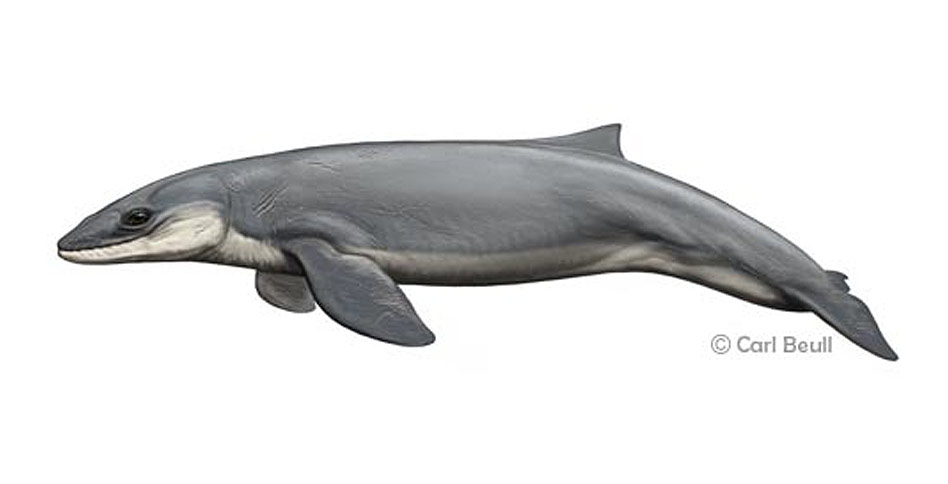
Janjucetus Hunderi
Age: 24-27 million years ago, Oligocene Epoch.
Range: This whale is so far only known from the coast of southeastern Australia.
Size: Little of the skeleton of Janjucetus is known. Based on the small size of the skull, Janjucetus is estimated to have had a body length of no more than 3.5 meters.
Anatomy: Janjucetus is remarkable due to its very short and triangular snout, heterodont dentition (having teeth of different types, including incisor-like teeth and others more like molars), large eye sockets, and relatively small size. Janjucetus would not have looked like any modern cetacean; indeed, the shape of its head is in some ways more similar to that of a seal or an extinct marine reptile than that of any modern whale, porpoise, or dolphin.
Locomotion: Largely unknown because of the poorly known skeleton of Janjucetus; however, it likely had tail flukes given the proportions of the last tail vertebrae in much older whales.
Sensory Abilities: The eye sockets of Janjucetus are very large compared to other toothed mysticetes and are proportionally gigantic compared to those of modern baleen whales. Aside from the bizarre walrus-like extinct whale Odobenocetops, the eye sockets of Janjucetus are proportionally larger than those of any known toothed whale. This suggests that Janjucetus relied on its keen underwater vision to find prey, similar to many modern predatory seals, sea lions, and extinct marine reptiles like plesiosaurs, ichthyosaurs, and mosasaurs.
Diet: The lack of arterial grooves on the palate of Janjucetus suggests that it did not have any baleen (unlike all modern baleen whales). At least one toothed mysticete (i.e. Aetiocetus weltoni) had both teeth and nutrient grooves on the palate, suggesting that it possessed both teeth and baleen.
Although the teeth of Janjucetus have finely sculptured cusps that make it superficially similar to the modern crabeater seal (which uses its uniquely shaped teeth to filter feed for small crustaceans), the teeth of Janjucetus lack the interlocking nature of the crabeater seal's teeth, and have large wear facets. This suggests that Janjucetus had a shearing dentition similar to that of many archaeocete cetaceans, such as Dorudon and Basilosaurus, and that its teeth were well suited for the consumption of flesh. Additionally, the teeth at the front of the snout form a 'rosette' or fan of teeth similar to some ancient plesiosaurs (Mesozoic marine reptiles). The jaws of Janjucetus are robust like Dorudon, and the teeth are very deeply rooted and strong. The dentition, in addition to the large eyes of Janjucetus, suggest that this animal was specialized for hunting and eating large, single prey items such as fish, and possibly marine birds such as early penguins.
Author: Summary written by Robert Boessenecker
References Consulted: Fitzgerald, E.M.G. 2006. A bizarre new toothed mysticete (Cetacea) from Australia and the early evolution of baleen whales. Proceedings of the Royal Society B 273:2955-2963.
Fitzgerald, E.M.G. 2010. The morphology and systematics of Mammalodon colliveri (Cetacea: Mysticeti), a toothed mysticete from the Oligocene of Australia. Zoological Journal of the Linnean Society 158:367-476.